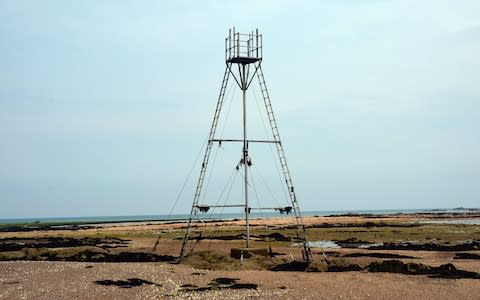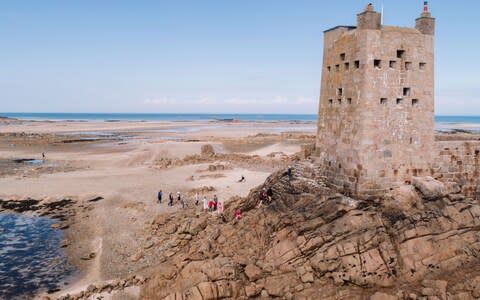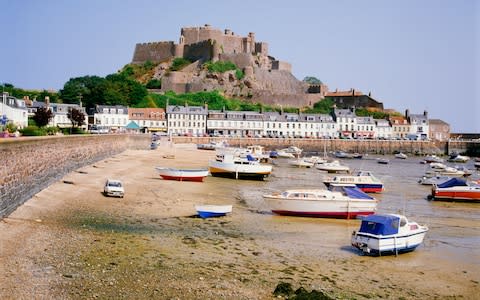How to roam Jersey's incredible (but dangerous) tidal shores

I’m standing a little slack-jawed in a scene reminiscent of The Martian when my guide, Trudy, hands me what looks like a chunk of smoothed triangular plaster.
“Just picture prehistoric man, crouching behind rocks out of the cold, waiting to ambush a wooly rhino,“ she colours for me in her slightly muted German accent.
We’ve been walking for over an hour across this growing stretch of barren wilderness in Jersey, sloshing through rock pools and stopping to look at the plethora of interesting things that Trudy has spotted along the way – dead catfish, tango-coloured crumb sponge and the brutal nature of the netted dog whelk have all featured.
In the short mile or so of the tidal zone that we’ve traversed, the landscape has changed almost every few feet. The pebble-dashed shoreline gives way almost instantly to a stretch of bright green seaweed so thick it could be mistaken for grass. Further out, ripple-lined sand still wet from the receding tide surrounds the brown seaweed-covered rocks of the middle shore.
Trudy practically squeals with delight when, half way through a deep pool that requires an almost balletic tiptoe in order to avoid the water tipping over the edge of our wellies and drenching our feet, she spots a mound ahead that from a distance looks like nothing more than another sand bank.

“I’ve not seen it like this for a while,” she says, pointing excitedly to what on closer inspection appears to be a mountainous graveyard of small shells, “the tides move things around almost everyday.” We scramble to the top and gaze back at the shore, now far enough away to count as the horizon. “This was once an Ice Age tundra,” Trudy says as we trudge down the other side, shells tumbling and tinkling in the wake of our boots.
“You can see the clay at the bottom of the pools in some parts – left behind from when the waterline was much lower. Just picture it. Vast grasslands with light forest all covered in permafrost and large wooly mammals roaming around. It was completely different to how it is today.”
She then reveals that the smooth lump of rock she’s pressed into the palm of my hand could well be a pre-Neolithic spear head. “The tooth of a woolly mammoth was found just over there near that rescue tower,” she explains, gesturing to the basic metal structure that looks a little like a lifeguard chair on steroids.

The tower’s purpose is simple yet necessary. Jersey is home to the largest rocky intertidal zone in Europe – up to 40 vertical feet during spring tides – and while it’s infinitely fascinating, it’s also incredibly dangerous. “Even locals don’t venture out here,” says Trudy. “People have to get rescued from that tower every year.”
The rising water is a danger that many underestimate. As the tide turns, it runs around a vast swathe of the area to create fast-flowing gullies that can’t be seen from much of the plain but can cut you off from the mainland in a matter of minutes.
Head out here without a guide, or at the wrong time, and you could find yourself up that tower, hopping up and down like a maniac, hoping that someone spots you before it gets dark (and no, of course there’s no phone signal out here).

Almost two hours after setting off from La Rocque, we reach our final destination – Seymour Tower. Here, the landscape transforms once again into something almost otherworldly. The sand is almost dry and large red rocks loom around us as we make our way up to the base of the beached 18th-century tower.
Built in 1782 in the aftermath of the Battle of Jersey, the square outline of the tower dominates the landscape. Unlike similar fortifications along the Jersey coast, Seymour Tower is uniquely square (it was considered highly unlikely that it would be attacked by canon from the sea, so didn’t need to be built with the round, deflecting curves that characterise the other towers).
Access is normally only possible for those staying the night (Jersey Heritage offer a very basic but rather unique experience from £350 per night; jerseyheritage.org), but you can climb the steps to the platform to take a break to enjoy the view.

As we look back towards dry land, a tractor can just be made out on the right, taking the opportunity to tend to the lowest levels of the nearby oyster beds – the largest in the British Isles. While the landscape is all but devoid of workers today, Trudy informs us that this salty part-time place was once utilised much more extensively.
She points out a letter “P” that has been carefully chiseled into the rock. “That’s the symbol of the Payne family and dates back to 1747,” she says. “They were the only family on the island with the right to gather seaweed throughout the year – everyone else was limited to just three months, between January and March – the Payne's just had to stick to the land they’d marked.”

One of the surprising aspects of this stretch of shoreline, protected under the Ramsar Wetlands Convention (ramsar.org), is that visitors can take away whatever they like – seaweed, shells, pre-Neolithic spearheads. It’s just commercial use that is heavily restricted, meaning that it’s not unusual to see a local or two down here in the afternoon picking up some fresh local ingredients for supper.
For seashore foraging enthusiasts there’s plenty to be found if you’re on the hunt for a free meal, and Trudy is an expert. She points out the holes of the lugworm which fishermen dig up fort bait, picks up razor clam shells and explains how they can be teased out of their holes by sprinkling salt at the edge, recounts how black winkles were all but eaten into extinction during the lean times of the Second World War, and explains why limpits were once considered ‘the poor man’s arbor’.
Then, of course, there’s the seaweed, in glorious variety. Bladderwrack, Trudy reveals, is the sea’s version of aloe vera. In spring, the weed is dotted with gooey little sachets that give a satisfying pop and ooze a gel-like substance when squeezed. "The gel has an SPF of 15," she says as she rubs it across her face, "so it’s a good natural alternative to suncream."

Egg wrack, we learn, is good for dogs' teeth and the number of large bubbles on a strand will tell you how old the plant is. Trudy also points out the edible weeds – serrated wrack, velvet horn and pepper dulse among them – the latter of which she pulls off a rock and hands to us to savour its tuffly umami flavour.
She then glances at her watch and picks up her pace – anxious that we make it past one of the more treacherous tidal gullies before it starts to fill.
There’s one last surprise waiting for us in the pools further up the shore; the Sea Hare. Camouflaged to hide among the seaweed, the Sea Hare looks more like a large aquatic slug than any kind of rabbit, but this slimy creature has some remarkable attributes.

Not only is it not a hare, it’s also not a slug. It is, in fact, a snail. It has a small internal shell that can’t be seen but can be felt as a hard ridge on its back, colouring that reflects the kind of weed it likes to eat, and a defence mechanism that involves shooting a bright purple ink at predators. Who needs to venture out with a passport when there’s this much to see in a small stretch of the British Isles?
Essentials
Walk
A guided walk on the seabed out to Seymour Tower with Jersey Walk Adventures costs from £16 for adults and £8 for children and takes around three hours (jerseywalkadventures.co.uk).

Evening bioluminescence (£17.50 adults, £8 children), wild vegetables of the ocean (£16 adults, £8 children), the oyster trail with oyster tasting (£18.50 adults, £9 children) and a full moon walk to Seymour tower (£21 adults) are also available.
What to do
There are plenty of other ways to make the most of Jersey's vast tidal zones. These include a trip with Jersey Kayak Adventures (from £41.50 adults, £29 children; jerseykayakadventures.co.uk) or a walk over to La Corbière lighthouse at low tide (jersey.com/la-corbiere).
When the water is high, you can pay a visit to the impressive Mont Orgueil Castle (jerseyheritage.org), explore the Jersey War Tunnels (jerseywartunnels.com) or visit La Mare Wine Estate for a cream tea or a tour and tasting (lamarewineestate.com).

Where to stay
If you’re looking for luxury, it’s hard to beat The Atlantic Hotel with its beautiful location, large rooms, spa, outdoor and indoor pools and pretty sea views (from £170; telegraph.co.uk/tt-the-atlantic-hotel/). For something a little wilder, try the Durrell Wildlife Camp (telegraph.co.uk/tt-Durrell-Wildlife-Camp-hotel).
What to eat
If you feel like splashing out, make sure you sample the fine dining menu at The Atlantic Hotel’s Ocean Restaurant which makes the most of fresh, locally sourced ingredients. The pan-fried John Dory fillet, seared hand-dived scallop and expansive cheese boards are definite highlights – as is the tasty Jersey Pearl cocktail (theatlantichotel.com/dining/ocean-restaurant; mains from £30).
For something a little more laid back, head down to Kismet Cabana on Ouaisne Bay which serves up a variety of street food cuisine from around the world in a beach setting beneath a gazebo at the edge of the sand (kismetcabana.com; mains from £6).
How to get there
You can fly to Jersey from various places around the UK including London City, Gatwick, Luton, Liverpool, Leeds, Southampton, Newcastle and Manchester with British Airways, EasyJet and Flybe.
If you prefer sailing to flying, Jersey is accessible by sea from Poole and Portsmouth with Condor (condorferries.co.uk). Once on the island, you can hire a car with Hertz (from £73; hertzci.com).
More information www.jersey.com


